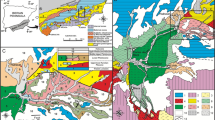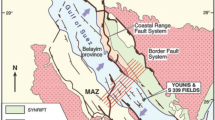Abstract
The Kopili Formation of North Cachar Hills, NE India has been studied to unravel its depositional mode and provenance. For this, a study of grain size distribution and heavy mineral assemblage of representative sandstone samples of the Kopili Formation was undertaken. Further, the published information on the Kopili Formation occurring in the adjacent areas was compiled. The Grain size study reveals that the Kopili sandstones are mostly bimodal and polymodal, fine-grained sands mixed with medium grained sands, moderately well sorted to poorly sorted, coarse skewed to near-symmetrical, and platykurtic to extremely leptokurtic. The Passega CM (C= one percentile and M= Median) pattern discloses saltation and suspension as the dominant transporting modes of the studied sandstones. Linear discriminant function (LDF) analysis reveals that the Kopili sandstones were deposited in beach and agitated shallow marine environment. The heavy mineral assemblage represented by zircon, tourmaline, rutile, garnet, chlorite clinopyroxene, staurolite, and opaque indicates mixed provenance (silicic igneous and metamorphic) for the Kopili sandstones. The zircon-tourmaline-rutile (ZTR) maturity index ranging from 31.03 to 88.41 (average 64.49%) discloses immature to sub-mature nature of the Kopili sandstones. Based on the study it is inferred that the Kopili sediments are of mixed provenance and deposited broadly in marine environment.
Similar content being viewed by others
References
Abuodha, J.O.Z. (2003) Grain size distribution and composition of modern dune and beach sediments, Malindi Bay coast, Kenya. Jour. African Earth Sci., v.36(1–2), pp.41–54.
Baiyegunhi, C., Liu, K. and Gwavava, O. (2017) Grain size statistics and depositional pattern of the Ecca Group sandstones, Karoo Supergroup in the Eastern Cape Province, South Africa. Open Geosci., v.9(1), pp.554–576.
Baiyegunhi, T.L., Liu, K., Gwavava, O. and Baiyegunhi, C. (2020) Textural characteristics, mode of transportation and depositional environment of the Cretaceous sandstone in the Bredasdorp Basin, off the south coast of South Africa: Evidence from grain size analysis. Open Geosciences, v.12(1), pp.1512–1532.
Baksi, S.K. (1962) Palynological investigation of Simsang River Tertiaries, South Shillong Front, Assam. Bull. Geol. Min. Metall. Soc. India, v.26, pp.1–22.
Bora, D.S., Baruah, N., Shrivastava, C., and Bharali, B. (2010) Depositional Environment and Sequence Stratigraphy of Eocene Reservoirs, Assam Shelf, India: A Multiwell Log Study. SPE Oil and Gas India Conference and Exhibition. OnePetro, 2010.
Cardona, J.P. Moral, Gutierrez Mas, J.M., A. Sanchez Bellon, A.S., Bella S.D., and Lopez, J.M. (2005) Surface textures of heavy-mineral grains: a new contribution to provenance studies. Sediment. Geol., v.174(3–4), pp.223–235.
Devi, N. R., Singh, Y.R., Abbott, M.B., and Devi, A.B. (2021) Palynology, palynofacies and organic geochemistry analysis of the late Eocene shale from Meghalaya, Northeast India. Jour. Earth Syst. Sci. v.130(2), pp.1–16.
Evans, P. (1932) Tertiary succession in Assam. Trans. Min. Geol. Inst. India, v.27(3), pp.155–260.
Folk, R.L. and Ward, W.C. (1957) Brazos River bar [Texas]; a study in the significance of grain size parameters. Jour. Sediment. Res., v.27(1), pp.3–26.
Folk, R.L. (1974) Petrology of sedimentary rocks: Hemphill Publ. Co., AustinTexas, pp.182.
Friedman, G.M. (1967) Dynamic processes and statistical parameters compared for size frequency distribution of beach and river sands. Jour. Sediment. Res., v.37(2), pp.327–354.
Friedman, G. M. (1979) Differences in size distributions of populations of particles among sands of various origins: addendum to IAS Presidential Address. Sedimentology, v.26(6), pp.859–862.
Goswami B, Ghosh D. (2011) Understanding the transportational and depositional setting of Panchet Formation, Purulia and Bankura districts of West Bengal, India — Evidence from grain size analysis. Front Earth Sci., v.5(2), pp.138–49.
Hubert, J.F. (1962) A zircon-tourmaline-rutile maturity index and the interdependence of the composition of heavy mineral assemblages with the gross composition and texture of sandstones. Jour. Sediment. Res., v.32(3), pp.440–450.
Itam, A.E and Inyang, D.O. (2015) Granulometry and Pebble Morphometry of Awi Sandstone, Calabar Flank Nigeria. International Jour. Engg. Appl. Sci., v.6(4), pp.15–27.
Kar, R. K., Handique, G.K., Mandal, J., Sarkar, S., Kumar, M. and Gupta, A. (1994). Palynostratigraphical studies on subsurface Tertiary sediments in Upper Assam basin, India. Palaeobotanist, v.42(2), pp.183–198.
Lindholm, R. (2012) A practical approach to sedimentology. Springer Science & Business Media.
Morton, A. C. (1985) Heavy minerals in provenance studies. In: Provenance of arenites. Springer, Dordrecht. pp.249–277.
Moulik, S.K. Roy, Singh, H.J., Singh, R.K., Akhtar, Md. S., Mayor, S. and Asthana, M. (2009) Sand Distribution Pattern and Depositional Model of Kopili Formation (Eocene) with Special Reference to Sequence Stratigraphic Framework from North Assam Shelf, Assam-Arakan Basin, India. Assam-Arakan Basin, India: Discovery Article 50196.
Mout J.M., and Sarmah, R.K. (2021) Depositional mode and Provenance of Kopili sandstones from parts of Dima Hasao District, Assam, NE India: Evidence from Grain size distribution and Heavy mineral assemblage. Disast. Adv., v.14(12), pp.33–47.
Parthasarathy, P., Ramesh, G; Ramasamy, S., Arumugam, T., Govindaraj, P., Narayanan, S., and Jeyabal, G. (2016) Sediment dynamics and depositional environment of Coleroon river sediments, Tamil Nadu, Southeast coast of India. Jour. Coastal Sci., v.3(2), pp.1–7.
Passega, R. (1964) Grain size representation by CM pattern as a geological tool. Jour. Sediment. Petrol., v.34 (4), pp.830–847.
Passega, R., and Byramjee, R. (1969) Grain size image of clastic deposits. Sedimentology, v.13(3–4), pp.233–252.
Poldervaart, A. (1955) Zircons in rocks; part 1, sedimentary rocks; part 2, igneous rocks. Amer. Jour. Sci., v.253(8), pp.433–461.
Rajganapathi, V. C., N. Jitheshkumar, N., Sundararajan, M., Bhat, K.H., and Velusamy (2012) Grain size analysis and characterization of sedimentary environment along Thiruchendur coast, Tamil Nadu, India. Arabian Jour. Geosciences, v.6(12), pp. 4717–4728.
Ramanathan, A. L., Rajkumar, K., Majumdar, J., Singh, G., Behera, P. N., Santra, S. C., and Chidambaram, S. (2009) Textural characteristics of the surface sediments of a tropical mangrove Sundarban ecosystem India. Indian Jour. Marine Sci., v.38(4), pp.397–403.
Sahu, B. K. (1964) Depositional mechanisms from the size analysis of clastic sediments. Jour. Sediment. Res., v.34(1), pp.73–83.
Salujha, S.K., Kindra, G.S., and Rehman, K. (1974) Palynology of the South Shillong Front-Part II. The Palaeogenes of Khasi and Jaintia Hills. Palaeobotanist, v.21(3), pp.267–284.
Samanta, B. K. (1968) Nummulites (Foraminifera) from the Upper Eocene Kopili Formation of Assam, India. Palaeontology, v.11(5), pp.669–682.
Samanta, B.K. (1971) Early Tertiary stratigraphy of the area around Garampani, Mikir-north Cachar hills, Assam. Jour. Geol. Soc. India, 12(4), pp.318–327.
Sarma, A., Ghosh, A.K., and Sarkar, S. (2014) First record of Coralline Red Algae from the Kopili Formation (late Eocene) of Meghalaya, N-E India. Natl. Acad. Sci. Lett., v.37(6), pp.503–507.
Saxena, R. K., and Trivedi, G. K. (2009) Palynological investigation of the Kopili Formation (Late Eocene) in North Cachar Hills, Assam, India. Acta Palaeob., v.49(2), pp.253–277.
Singh, H. P., and S. K. M. Tripathi, S.K.M. (1986) Palynology of the Jaintia Group (Palaeocene-Eocene) exposed along Jowai-Sonapur Road, Meghalaya, India (Part II). Data analysis and interpretations. Palaeobotanist, v.35(3), pp.301–313.
Srivastava, A.K., Ingle, P.S., and Khare, N. (2010) Textural characteristics, distribution pattern and provenance of heavy minerals in glacial sediments of Schirmacher Oasis, East Antarctica. Jour. Geol. Soc. India, v.75(2), pp.393–402.
Stanley-Wood N and Lines RW. (1992) Particle size analysis. Camb. Royal Soc. Chem., Spec. Publ., pp.101–103.
Tandon, S. K. (1972) Heavy minerals and quartz axial ratios as provenance indicators in the Siwalik sediments around Ramnagar, Kumaun Himalaya. Himalayan Geol., v.2, pp.206–221.
Trivedi, G.K. (1985) Palynology of the Kopili Formation (upper Eocene) exposed along Jowai-Badarpur Road, meghalaya. Jour. Indian bot. Soc., v.64, pp.66–72.
Trivedi, G. K. (2009). A palynofloral diversity in the Kopili Formation (Late Eocene) from North East India. Acta Musei Nationalis Pragae Series B-Historia Naturalis, v.65, pp.9–24.
Trivedi, G.K., and Saxena, R.K. (2000) Palynofloral investigation of the Kopili Formation (Late Eocene) exposed near Umrongso in North Cachar Hills District, Assam, India. Palaeobotanist, v.49, pp.269–280.
Trivedi, G.K. and Ranhotra P.S. (2015) Palynofloral Evidence for Palaeoecology and Depositional Environment of the Kopili Formation (Late Eocene), Jaintia Hills, Meghalaya. Jour. Geol. Soci. India., v.86(1), pp.33–40.
Zaidi, S. and Chakrabarti, S.K. (2006) Sequence Stratigraphy and Depositional Environment of the Kopili Formation in the Area Between Borholla and Khoraghat, Dhansiri Valley, South Assam Shelf. 7th International SPG Conference & Exposition at Kolkata, India.
Acknowledgements
The authors express their sincere gratitude to the Head, Department of Applied Geology, Dibrugarh University (DU), Assam for providing laboratory facilities for this study. The research work of this paper was financially supported by the DU Research Fellowship (DU/JR-A/DU Research Fellowship). The authors are thankful to the Editors of JGSI and the anonymous reviewers for giving constructive and valuable comments to improve the manuscript.
Author information
Authors and Affiliations
Corresponding author
Rights and permissions
About this article
Cite this article
Mout, J.M., Sarmah, R.K. Unraveling Depositional Mode and Provenance of Kopili Formation, Northeast India. J Geol Soc India 98, 496–504 (2022). https://doi.org/10.1007/s12594-022-2007-0
Received:
Accepted:
Published:
Issue Date:
DOI: https://doi.org/10.1007/s12594-022-2007-0




